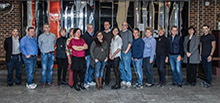About
A leading, cutting-edge graduate program in ensemble, experimental, interdisciplinary performing arts production. Students collaboratively create performances that draw upon and hybridize theater, performance art, dance, music, puppetry, and various other experimental forms.
Bringing together experienced artists from a wide range of backgrounds, this intensive two-year program teaches interdisciplinary collaboration as a skill in itself, and multimedia computer programming as a tool for both practical production and collaboration. Students in the program share an interest in digital media and use of technology in performance, and multimedia work is encouraged and supported.
Following an initial term of intensive collaborative creation on campus, students are encouraged to expand into the community through socially engaged practices, and have opportunities to present collaborative works in New York City venues, providing unique production opportunities. The PIMA M.F.A. program culminates in a collaborative thesis produced off-campus.
Mission
The Performance and Interactive Media Arts M.F.A. provides students with training, theoretical and technical knowledge, and practical experience in the conceptualization and production of collaborative, multi-disciplinary artworks.
Students learn to use technology as a means of extending their personal artistic practice and facilitating cross-disciplinary artistic collaborations. Students with diverse academic, artistic, professional, and cultural backgrounds enter the program, form a close-knit community, and work in collaborative groups throughout the course of study, with close mentoring by faculty members from the departments of the School of Visual, Media and Performing Arts, including Art, the Conservatory of Music, Film, Television and Radio and Theater. Students learn socially engaged practices, working with various communities to create collaborative projects shared with the public.
In the second year a major collaborative thesis production is created and presented in professional and alternative venues in the New York City area.
Goals
Meta-goals
- Form a functional, cohesive, supportive, and self-managing community of artists that supports collaborative groups and projects.
- Collectively agree, during the course of study, to place the work of the community (and the collaborative groups that form from it) before individual artistic work.
- Collectively agree to place a high priority on mutual respect and constructive behavior in interactions with collaborative group members and communities.
- Collectively understand that the PIMA studio is your fellow students, and that to spend time “in the studio” means to spend time with your collaborators, regardless of the physical location of the meeting. Collectively agree that students will spend, on average, 20+ hours per week in face-to-face collaborative situations.
Goals
- Provide background in current collaborative performing arts practices, and a historical framework for understanding these practices.
- Provide background and training in collaborative co-creation techniques and strategies through a broad range of practical experiences.
- Provide background and training in techniques and strategies for creating and presenting live performance.
- Provide background and training in live performance production technology including interactive media programming.
- Provide background and practical experience in researching, establishing, and co-producing socially engaged performances in cooperation with a community or community group.
- Provide background and training in university-level teaching and course design.
- Provide experience of performing arts production in professional venues.
- Provide experience in event publicity, documentation, archiving, and electronic distribution.
- Provide a background in business models suited to the creation of professional performance.
Student Objectives
- be able to research, analyze, and write scholarly papers on current collaborative performing arts practices and demonstrate knowledge of a historical framework for understanding current collaborative performing arts practices
- demonstrate knowledge of, and proficiency in, collaborative co-creation strategies within a broad range of practical experiences
- demonstrate practical and theoretical knowledge of techniques and strategies for creating and presenting live performances
- participate in live performance training, preparation, exercises, and practice as part of the course of study
- demonstrate practical and theoretical knowledge of live performance production technology and interactive media programming
- successfully research and establish a relationship with a community or community group
- collaboratively co-produce a performance in cooperation with a community or community group
- design university-level courses, with syllabi, schedules, objectives, assignments, and practical sample classes
- engage fully in collaborative co-creation of all major projects in required classes throughout the course of study
- demonstrate practical performing arts production in professional venues
- demonstrate ability in event publicity
- demonstrate ability in event documentation
- demonstrate ability in archiving and electronic distribution of event documentation
Statement of Collaboration
The PIMA M.F.A. emphasizes collaborative, cross-disciplinary artistic production. While there is much space for individual effort and individual expression within the curriculum, the production projects completed in the required PIMA courses will all be collaborative in nature. For the purposes of this program, collaboration is defined as the act of working together with one or more people in the creation of an artistic product. The hope is that this working together will also be collective, or shared equally by all members of the group, and, as much as possible, non-hierarchical, or having no formal ranking among group members.
The Nature of PIMA Collaborative Groups
Collaborative groups for PIMA 7010-7030 projects will have certain characteristics:
- They will consist, minimally, of two or more matriculated students currently enrolled in the same required PIMA course (in most cases, this means two or more students who entered the program in the same semester).
- They will represent two or more broad artistic disciplines within the collaborative group (e.g. Music and Theatre).
- They may include, without any special permissions, collaborators from another PIMA sequence who are currently enrolled in the program and taking classes (e.g. two incoming students in PIMA 7010 and two outgoing students in PIMA 7030 may wish to collaborate in a fall semester; this collaboration would require no special permissions).
- They may include, with permission of the director, collaborators not matriculated in the program. These outside collaborators will have a brief interview with the program director and the faculty member supervising the production work for the semester. Following the interview and the approval of the program director, a brief discussion between the collaborative group, the program director, and the supervising faculty member will need to be arranged before such a collaborative group can begin work.
- There will be at least two collaborative groups formed for every six students in a required class.
Working with Outside Collaborators
Outside collaborators (collaborators not matriculated in the program) may work with their PIMA collaborative group on and off campus. They will need to sign in as visitors each time they visit the campus. They will not have 24-hour access to the campus, and so will have to leave campus by 11:00 PM Monday-Thursday, and by 6:00 PM Friday-Sunday. Certain limitations and requirements will apply to outside collaborators.
- Outside collaborators will need to file a contact information form with the program director (this can be done at the interview).
- Outside collaborators may not use the technology housed in any Brooklyn College facilities.
- Outside collaborators may not operate any equipment signed out from Brooklyn College departments; however they may operate equipment signed out from the PIMA program with permission of the director.
- Outside collaborators may not reserve time in any Brooklyn College facility, nor reserve Brooklyn College equipment for sign-out.
- Outside collaborators may not be in any Brooklyn College facility without being accompanied by a matriculated PIMA student.






